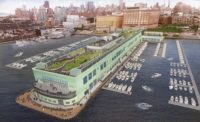A Monumental Makeover for the St. Louis Arch


One of America's most iconic landmarks exists in one of the most incongruous settings-divided by infrastructure from the city it represents. Now, crews are rebuilding that infrastructure so that the St. Louis Arch will by 2017 be reconnected to the downtown area.
ENR visited the project as part of its Low & Slow Across America's Infrastructure tour in May to investigate how agencies are getting important projects done in an era of constant funding battles. Those agencies included numerous public-works departments situated deep in the trenches.
In a time of tight budgets and pressing infrastructure needs, an array of private and public stakeholders pulled together to fund the $380-million project. The main agencies are the Missouri Dept. of Transportation, the National Park Service, the Great Rivers Greenway, the city of St. Louis and the Bi-State Development Agency, says Ryan McClure, spokesman for CityArchRiver, the public-private partnership formed for the project.
"Ever since 1965, [officials] have been talking about how to connect the arch to the city," says McClure. "There have been many plans but no traction." That changed, he added, when in 2007 St. Louis Mayor Francis Slay (D) convened a meeting of local leaders to push the issue. "A lot of the collaboration wasn't so much the buy-in from the community as in from the leadership-the folks going around the table saying 'I need buy-in from you and you and you,'" says Drew Gates, a MoDOT spokesman.
MoDOT led the way by applying, in 2011, for a $20-million TIGER grant and contributing $25 million. Deanna Venker, former MoDOT area engineer and now St. Louis traffic commissioner, says a new NPS plan galvanized MoDOT to take action. "We saw the writing on the wall: Everything was coming together on this project that had been around for 20-plus years," she recalls. "There was always a money issue, it never was the right time, and we never had the right people coming together-then we had the right leadership."
McClure calls the grant "a huge step forward." He adds: "At that point, it was just an idea. It had a lot of political and community support, but that was the first real large chunk of funding that came through." CityArchRiver raised another $10 million in private donations.
The landscape design firm Michael Van Valkenburgh Associates won a design competition held in 2009. "It was probably the hardest competition I'd ever been a part of," says Gullivar Shephard, a principal with MVVA. "There are so many complexities in working with the National Park Service; you can't just solve the problem with architecture and retail. It was a fascinating combination of how to craft places not only [with] problem-solving and engineering solutions but also by understanding how people behave."
Voters approved a sales tax hike in 2013 that provided $90 million for the project, says McClure. "We have not found a example anywhere else in the country of a local jurisdiction voting to tax itself to improve a national park," he adds.
Historic Gap
The national park and the arch began construction in the early 1960s, while Interstate 70 also was being built, notes Patrick Boyle, construction manager for Alpha Corp., which represents the National Park Service in managing construction of the NPS-owned sections of the project. Eero Saarinen, architect of the arch monument, designed pedestrian bridges to span depressed lanes between the park and the city, but they were never built.




_ENRreadyCover.jpg?height=200&t=1646347837&width=200)


